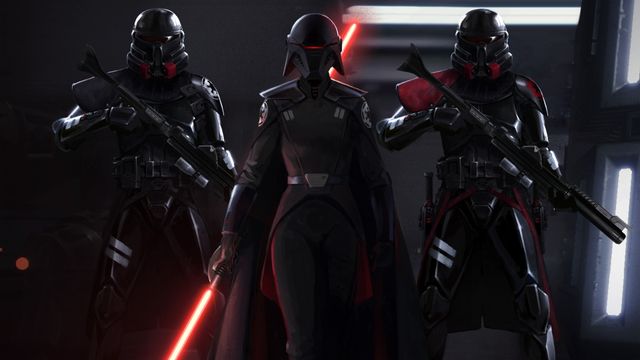Spoiler Alert: Jedi: Fallen Order

When I first saw the Jedi: Fallen Order banners showing up in Origin, I was intrigued. Something struck me that this could be a really good game. Possibly good like Knights of the Old Republic, one of my favorite games.
That’s a high bar. Fallen Order is not KOTOR; is it as good? I don’t know, and I don’t know if the question even makes sense.
But I had a great deal of fun playing it, and also appreciate what it did with video games as a creative media. It’s a good game, in my opinion, and shows what can be done with Star Wars as a video game environment.
Gameplay

Fallen Order is not an RPG. There are level-up and crafting mechanics, but those are the only RPG-like dimensions; there’s no morality system, no conversation trees, and the only real customization points for your character are lightsaber aesthetics and which order you choose to add skills at level-up.
It’s a straight puzzle-platformer with fantastic combat mechanics. If you think “Lara Croft: Jedi Knight”, you wouldn’t be too far off.
And this game is hard, though I don’t consider myself a particularly good gamer. I played most of the game on “normal” difficulty (Jedi Knight), and found it challenging but rewarding. I haven’t played many of the older Star Wars Jedi games (logged a few hours in Jedi Academy), so I don’t have a good comparison. But this is probably one of the most difficult games I have played in a while. Boss fights reliably took a dozen tries, at least. Some (particularly Ninth Sister and the Wanderer) took me substantially more. But with one exception, the challenge was rewarding, so I kept plugging away and eventually beating them. (I found the fight with the gryffon thing on Dathomir annoying, so I beat it in Story Mode.)
I liked the lightsaber combat a lot. The game is a progressive sequence of figuring out how to make the most of the new moves and abilities you collect as Cal progresses. The game is advertised as letting you “feel like a Jedi”, and I think there it delivered. It isn’t lying, however, when it warns you that you really need a controller when you try to play with keyboard & mouse — I don’t think it’s physically possible to do some of the combos you need to be effective in later-stage battles without a controller.
The fights also really felt like dueling, and not just spamming attacks and health until the boss falls. Combat focuses on combinations of parries, attacks (of various forms), and force powers. It also doesn’t reward Use the Cool Stuff; while the dual lightsaber is incredibly useful in some situations, it is not effective in single combat, so you need to think about what will be most effective in each particular encounter.
Story and Characters
The story was interesting and well-executed, but I didn’t find it particularly memorable. I don’t remember any moments that were as emotionally impactful as the reveal at the mid-point of Knights of the Old Republic.
The characters carried it along well enough, though with flaws better covered by others. Greez was fun. Merrin and Trilla were probably the most interesting characters, but significantly underexplored. I also think Aimee Hart has a pretty good take that there is a lot of great character and relational material the game overlooks, to its detriment. It also sounds like the reasons that went into Cal’s design were pretty bad. I also found an essay a couple months ago, that I can’t locate again, arguing that Cal’s development overturns the toxic masculinity that often accompanies white male video game protagonists, showing Cal connecting more with his emotions.
The game’s droid, though. BD-1 is one of my favorite droids now. He’s a small two-legged droid, much like a mini chicken walker, that the game imbues with a good deal of personality.
Progression
One thing I think the game did especially well is leverage the progression of the player’s skills for worldbuilding and storytelling. It is important to note that the character does not progress much in power — there is one level-up each to increase lightsaber damage, health, and force capacity, and each force power has a power-increasing level-up, but you don’t have the steady crawl of strength and HP increases. Increased progression comes primarily through additional skills (some of which, like the split saber attack, have more power than earlier skills) and your own practice with the combat mechanics.
There are quite a few boss fights, and the second half of the game keeps the coming hard and fast, both through scripted fights and the random appearances of bounty hunters that provide a fight comparable to an early-mid-game boss fight (the first 2–3 times, they wasted me handily; by about midgame, I was able to reliably beat the bounty hunters). They get hard; as I mentioned, Ninth Sister and the Wanderer are especially potent foes. It may well have taken me 50 tries to beat Ninth Sister.
But the recurring theme is Cal’s confrontations with the game’s principal antagonist, the Second Sister. She’s a fascinating character in her own right, but the connection of her combat with the player’s skill progression and end-game reveal are a master class in using gameplay to communicate.
There are three fights with Second Sister. The first is a brief battle in the game’s initial escape sequence; you exchange a few parries, and it’s clear that Cal is entirely unprepared to face her. The duel ends quickly with the Mantis rescuing Cal.
The second confrontation is about 40% through the game, where she intercepts Cal while he is trying to get to the second tomb. This is a full duel, and brutal; I did not feel ready for it, either in terms of Cal’s skills or my own practice with the game. You also don’t actually win this duel; you survive and deal damage long enough for BD-1 to rescue you, which happens when the Sister reaches about 25% health.
The game reached its climax in the Second Sister’s own turf, dueling her for the holocron in the heart of the Fortress Inquisitorious. She is in full form; after a half-dozen defeats, I figured out the trick and was able to dispatch her relatively quickly, thanks in part to skill upgrades and a better grasp of the interaction of force mechanics. The Power of Friendship upgrade, so health packs replenish force power, was critical. But it’s important that she didn’t get any easier; I just got better at the game, and had a few character skills that let me maximize those abilities.
Then, with the Second Sister defeated and the holocron in my possession, Darth Vader shows up.
And completely destroys me in a single blow.
After Vader kills you the first time — an act I’m not sure it’s even possible to prevent — you get his tactical advice card in the databank. It provides one bit of advice: run.
So you run, and it’s a Tomb Raider-style escape chase to get off the fortress, get rescued by the Mantis crew, and get the end-game cut-scene to wrap up the story.
The result was a brilliant use of gameplay to apply the principle of “show, don’t tell” to communicate just how powerful Darth Vader actually is. You just beat the Second Sister, the game’s toughest baddie, who you could not come close to matching for most of the game. If the duel in the end was relatively easy, as it was for me, it creates a sense of “I’ve gotten pretty good at this!”
And Darth Vader is playing an entirely different game. There is absolutely no way to match his power or skill. You got good, you defeated the most difficult villain in a difficult game, and cannot touch Vader.
When rewatching Lord of the Rings last week, I was reminded of this when Sauron steps onto the field in the opening battle: no one stands a chance.
But, and this is a significant problem: this bit of brilliant storytelling mechanics turns a compelling woman of color into a device to talk about Darth Vader. The mechanism could have been put in service of a better arc and turn.
Conclusion
There’s a lot of good debate and critique to be had about what Fallen Order did or did not achieve with its story and characterization. I don’t think either rose to the heights of either Knights of the Old Republic or the older game’s flawed but brilliant sequel.
But I had a great deal of fun playing the game, the duels were satisfying, and I think there were things it did really well, particularly to showcase the capabilities of gameplay itself as a narrative device. There’s a pretty good chance I’ll play it again, possibly at a harder difficulty.